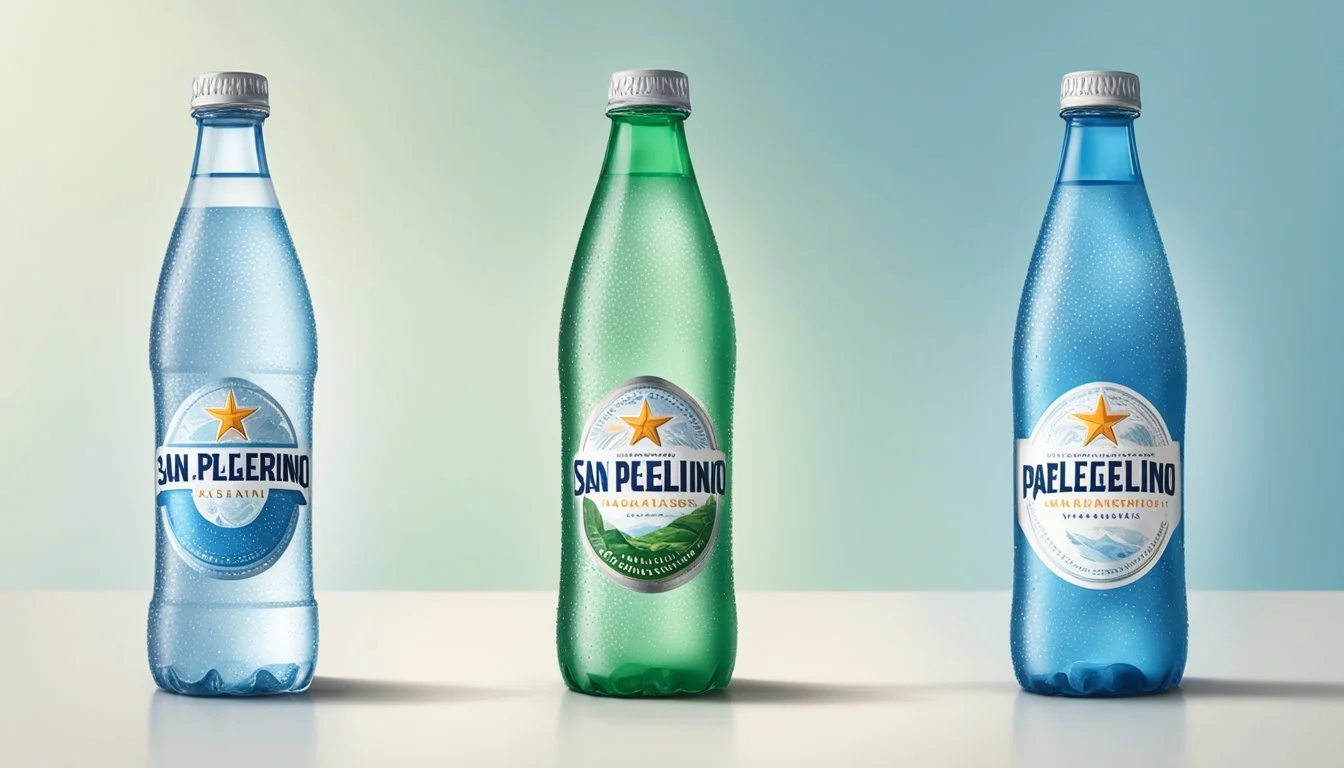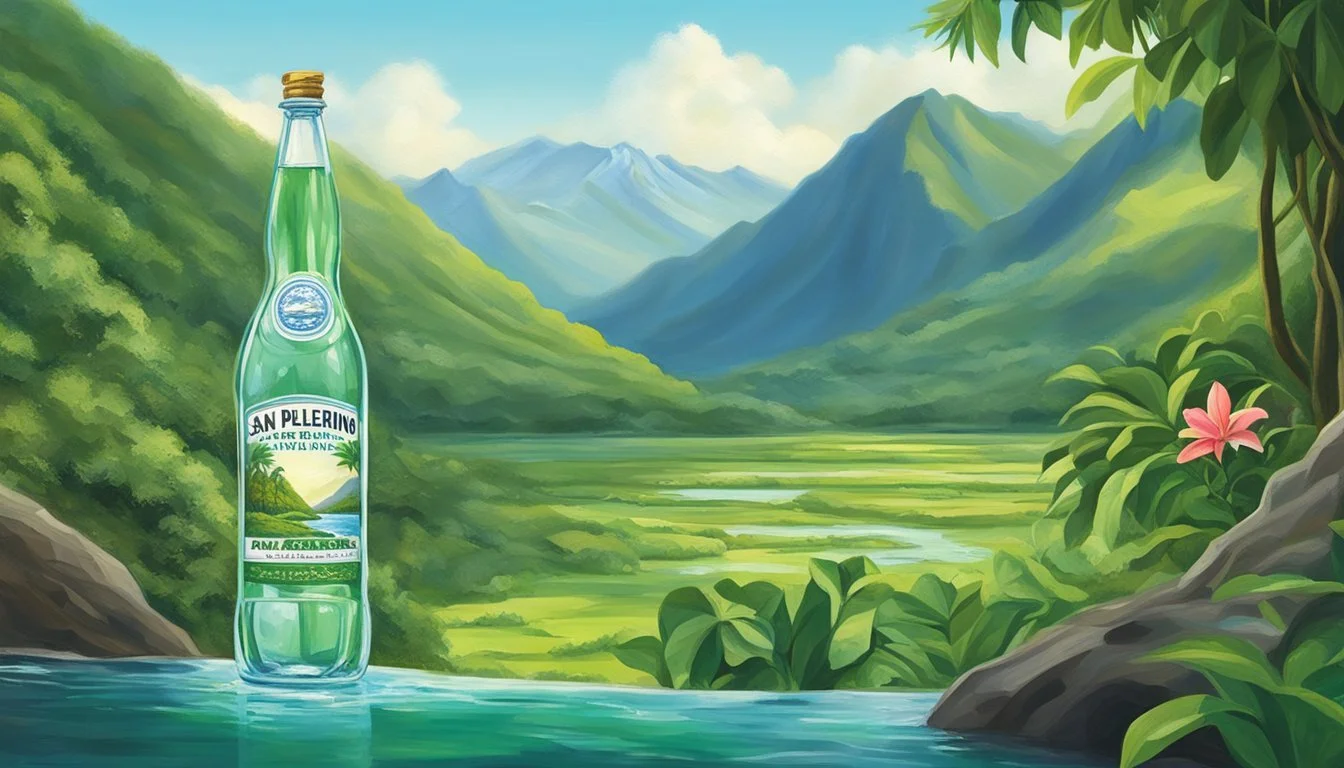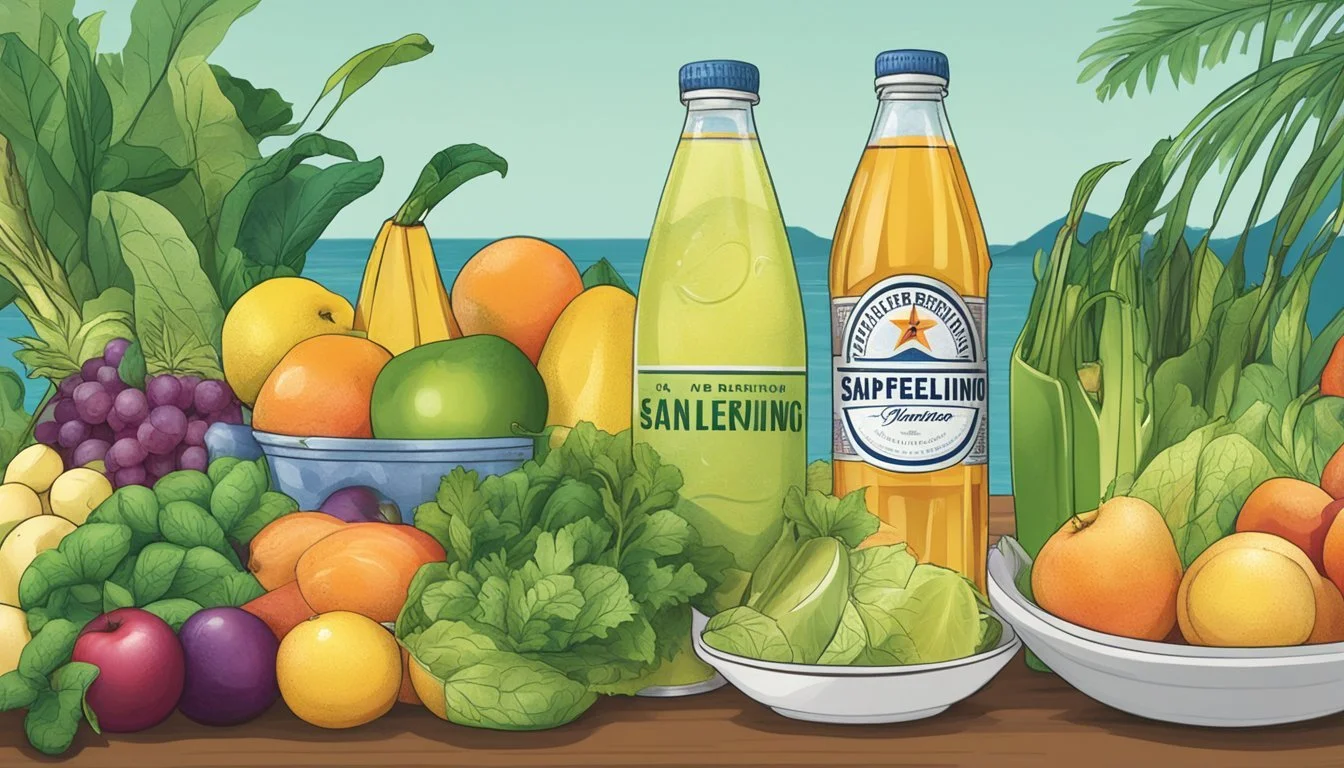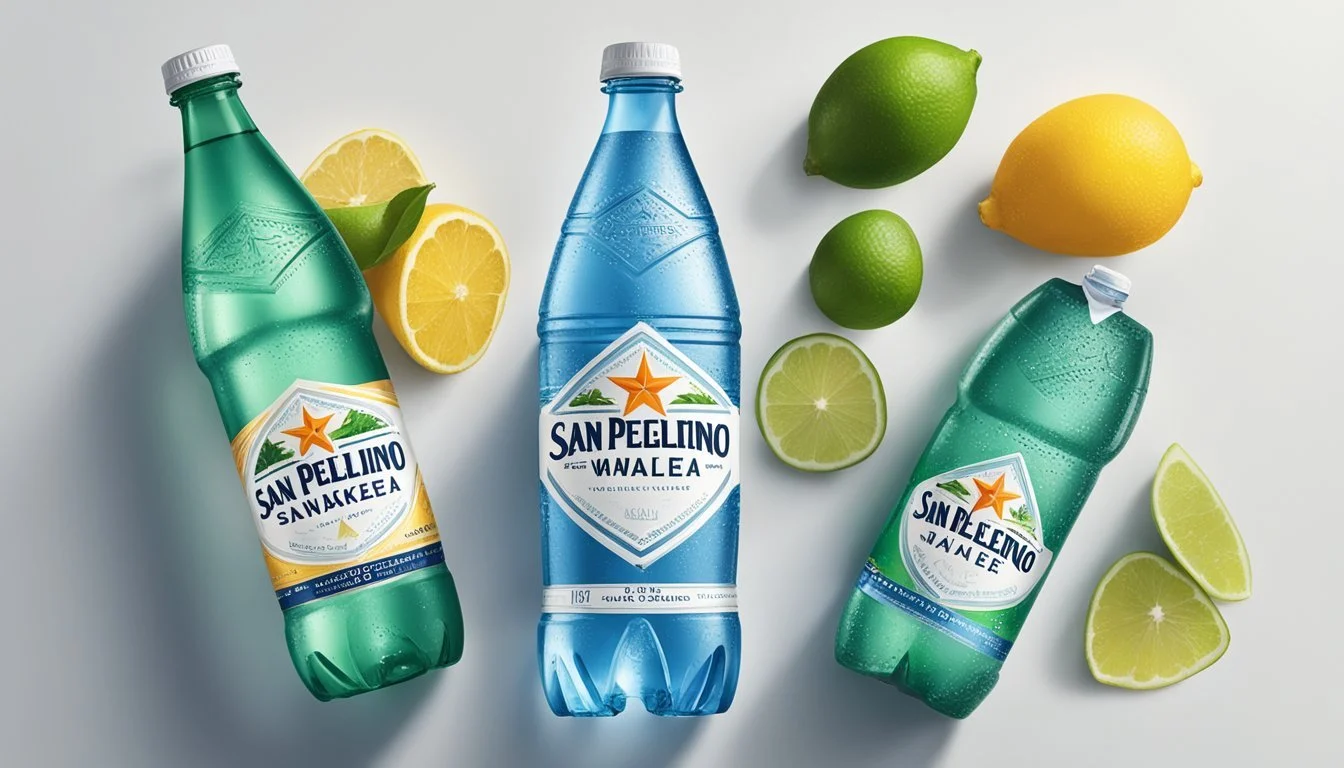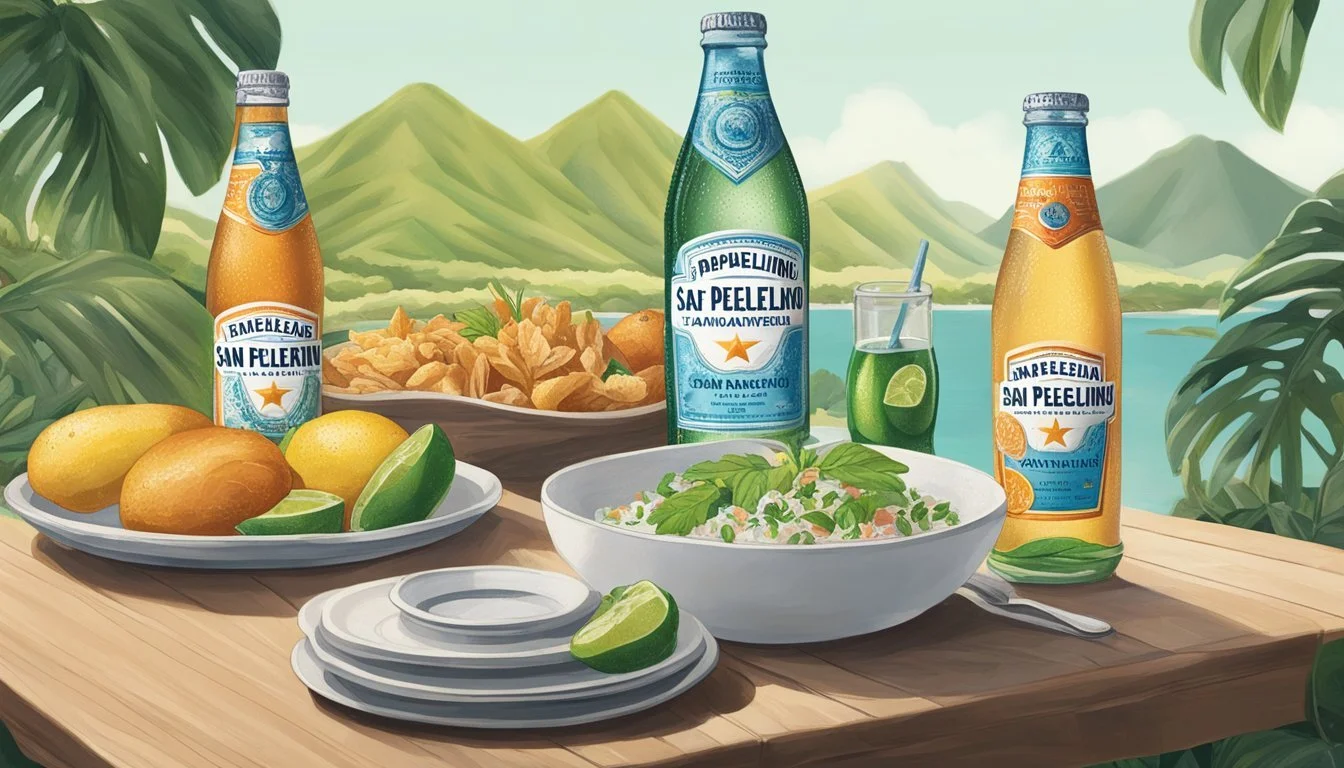San Pellegrino vs. Waiakea
Comparing Premium Bottled Waters
Choosing between San Pellegrino and Waiakea bottled water can be challenging for consumers who value quality and sustainability. San Pellegrino, known for its fine dining appeal and mineral-rich content, offers a taste revered by many for its effervescent character. On the other hand, Waiakea stands out with its commitment to environmental responsibility, being the first U.S. bottled water to achieve Carbon Neutral certification, and its high pH level suggests a smooth, refreshing flavor.
San Pellegrino is synonymous with sophistication, often gracing the tables of upscale restaurants. This Italian spring water, with origins dating back to 1899, boasts a harmonious blend of minerals that contribute to its distinctive taste. Its sparkling variant adds an elegant fizz, making it a favorite for those who appreciate a refined drinking experience.
Waiakea distinguishes itself through its volcanic filtration process, imbuing the water with electrolytes and minerals that support overall hydration. Additionally, Waiakea's dedication to social responsibilities, including donating a portion of revenues to nonprofits, aligns with the values of ethically conscious consumers. This blend of purity, taste, and planetary care makes Waiakea a formidable choice for bottled water enthusiasts.
History and Origin
San Pellegrino and Waiakea each boast unique origins that underscore their distinct qualities. This section delves into their beginnings, highlighting their respective ties to Italy and Hawaii.
San Pellegrino: Italian Legacy
San Pellegrino's journey began in 1899 when it was officially recognized and listed on the Milan Stock Exchange. The company quickly established itself, producing its first bottles of natural spring water that same year. Sourced from the Italian Alps, San Pellegrino water is renowned for its high mineral content.
By the early 20th century, San Pellegrino had expanded internationally, exporting over 5,000 bottles outside Italy within its first year of operation. The brand's mineral-rich water, discovered in the San Pellegrino Terme area, gained popularity for its purity and fine dining reputation. Notably, it contains at least 10 naturally occurring minerals, contributing to its distinguished taste and health benefits.
Waiakea: Hawaiian Beginnings
Waiakea, founded more recently, is steeped in Hawaiian tradition and environmental consciousness. The brand emerged with a mission to blend premium quality with sustainable practices. Sourced from the snowmelt and rain on the Mauna Loa volcano, Waiakea water filters through volcanic rock, infusing it with electrolytes and minerals.
In addition to its unique geological origin, Waiakea prides itself on being the first U.S. bottled water to achieve CarbonNeutral certification. Its founders emphasize community support, donating over 5% of revenue to various nonprofits in Hawaii and globally. Waiakea's commitment to sustainability and social responsibility sets it apart in the bottled water market.
Source and Natural Composition
San Pellegrino and Waiakea are notable for their unique sources and mineral compositions, which significantly influence their taste and health benefits.
The Springs of San Pellegrino
San Pellegrino water originates from natural springs in the Italian Alps. The water is filtered through dolomite rocks, which enrich it with minerals such as calcium, magnesium, sodium, and potassium. This process gives San Pellegrino its distinct mineral profile and underlying hints of natural carbonation.
The springs of San Pellegrino are renowned for their purity, and the water is known to be naturally recharged by precipitation. These natural elements contribute to its crisp and refreshing taste, making it a popular choice for those who appreciate finely balanced mineral water.
The Aquifers of Waiakea
Waiakea water is sourced from aquifers located on the Mauna Loa volcano in Hawaii. The water is filtered through volcanic rock, which imparts it with a distinct mineral composition, including silica, calcium, magnesium, and potassium. This volcanic filtration process not only enriches the water but also enhances its purity.
The aquifers provide an abundant and sustainable water source. Waiakea is also noted for its alkaline pH level, which ranges from 7.6 to 8.2, contributing to its smooth and slightly sweet taste. This natural water source ensures Waiakea stands out in the premium bottled water market.
Production Process
San Pellegrino and Waiakea employ distinct production methods, emphasizing unique aspects such as native mineral content and sustainability practices.
San Pellegrino's Bottling Methods
San Pellegrino originates from Italian springs, capturing natural mineral-rich water. The water undergoes minimal processing to maintain its purity.
Packaging: The characteristic green glass bottles, with a signature star, are meticulously sterilized to ensure consumer safety.
Carbonated Water: The water is naturally carbonated, but additional carbonation is added during bottling to achieve its sparkling quality.
The minerals, such as calcium and magnesium, remain intact. San Pellegrino has been trusted for its consistency since its inception in 1899.
Waiakea's Sustainable Approach
Waiakea focuses on sustainability, from sourcing to packaging. The water is sourced from Mauna Loa volcano, filtered through porous volcanic rock.
Reverse Osmosis: Waiakea uses reverse osmosis for further purification, ensuring quality without losing essential minerals.
Carbon Footprint: The brand emphasizes reducing its carbon footprint. It was the first U.S. bottled water company to be certified Carbon Neutral.
Sustainability: They donate over 5% of revenue to non-profits, promoting environmental sustainability. Packaging uses 100% post-consumer recycled polyethylene terephthalate (rPET), reducing plastic waste.
This eco-conscious approach offers an appealing option for environmentally aware consumers.
Taste and Palate
The sensory experience of both San Pellegrino and Waiakea involves distinct characteristics, making them uniquely appealing. San Pellegrino offers a lively, sparkling sensation that works well as a palate cleanser, while Waiakea delivers a smooth and sustainable drinking experience with rich mineral content. Each water brand brings a notable taste profile to the table.
Sparkling Sensation: San Pellegrino
San Pellegrino is known for its crisp, sparkling water that provides a refreshing and lively taste. With its natural carbonation, this mineral water offers a slightly salty and tangy flavor, derived from its rich sodium and bicarbonate content.
Its fizzy quality makes it an excellent palate cleanser, often used to amplify the flavors of accompanying food and beverages. Bottled at the source in San Pellegrino Terme, Italy, this water has a long-standing reputation for its purity and complex mineral taste, making it popular among those who enjoy a vigorous, bubbly drinking experience.
Smooth and Sustainable: Waiakea
Waiakea water, sourced from the Mauna Loa volcano in Hawaii, delivers a smooth, slightly sweet flavor with a silky texture that makes it very pleasant to drink. This artesian water is filtered through volcanic rock, enriching it with essential minerals like calcium, magnesium, and silica.
Waiakea’s water taste is soft and clean, with a subtle mineral profile that’s balanced yet distinctive. Apart from taste, Waiakea emphasizes sustainability with eco-friendly packaging and support for clean water initiatives, appealing to environmentally conscious consumers without compromising on the quality and palate-pleasing attributes of the water.
Health Benefits and Concerns
San Pellegrino and Waiakea offer unique advantages when it comes to health benefits and potential concerns. This section analyzes the mineral content, hydration benefits, and any health implications of each water brand.
Mineral Content of San Pellegrino
San Pellegrino is rich in various minerals essential for health. The water contains:
Calcium: Supports bone and teeth health.
Magnesium: Essential for muscle function and preventing cramps.
Bicarbonates: Help in digestion and maintaining pH balance.
San Pellegrino's mineral-rich profile can contribute positively to hydration and overall wellness. The moderate sodium content can aid in maintaining blood pressure, but those on a low-sodium diet should consume it mindfully.
Waiakea's Natural Advantages
Waiakea stands out with its natural alkalinity and unique mineral content. The water's natural filtration through volcanic rock adds beneficial minerals like:
Silica: May support bone, hair, skin, and nail health.
Electrolytes: Aid in hydration and maintaining pH balance.
Its naturally alkaline pH of around 8.8 can help neutralize acidity in the body. Additionally, Waiakea's fluoride content is beneficial for dental health, although its presence should be noted by those monitoring fluoride intake.
Environmental Impact and Sustainability
Both San Pellegrino and Waiakea take notable steps towards reducing their environmental impact and promoting sustainability. Each brand employs unique methods to ensure eco-friendly production and packaging practices.
Eco-Friendly Practices of Waiakea
Waiakea is committed to sustainability through several innovative initiatives. They use 100% RPET (recycled polyethylene terephthalate) for their bottles. This reduces the consumption of new plastic, significantly lowering the brand's carbon footprint.
The company’s water source is a naturally renewable spring in Hawaii, which allows for minimal environmental disruption during extraction. Additionally, Waiakea is Certified CarbonNeutral®, emphasizing their dedication to reducing carbon dioxide emissions.
Waiakea also supports reforestation projects and clean water access initiatives in developing countries. Such efforts help balance the ecosystem and demonstrate a broader commitment to environmental and social responsibility.
Green Initiatives by San Pellegrino
San Pellegrino prioritizes sustainability through multiple green initiatives. They focus heavily on the efficient use of water resources at their bottling sites. The brand's Italian source undergoes rigorous monitoring to ensure it is used sustainably.
The packaging for San Pellegrino also incorporates recycled materials, aiming to minimize waste. They actively participate in programs to reduce carbon dioxide emissions, including optimizing logistic routes to lower transportation impacts.
In addition, San Pellegrino supports community-based environmental projects. These include reforestation and conservation efforts in various regions, aligning with their overall goal of increasing environmental sustainability while providing high-quality bottled water.
Comparison of Physiochemical Properties
When comparing San Pellegrino and Waiakea, it’s essential to examine key physiochemical characteristics such as pH levels, acidity, and mineral content. These properties not only affect their taste but also their potential health benefits.
pH Levels and Acidity
San Pellegrino has a pH level of approximately 7.7, making it neutral to slightly alkaline. This balance contributes to its smooth taste and is sufficient for those looking for a regular mineral water with slight alkalinity.
Waiakea, on the other hand, has pH levels ranging from 7.6 to 8.2. Its naturally alkaline nature is derived from volcanic rock filtration, providing a smoother mouthfeel and potential health benefits associated with alkaline water, such as neutralizing stomach acid.
Mineralization: TDS and Hardness
San Pellegrino is well-known for its high mineral content, which includes calcium, magnesium, and sulfates. It has a TDS (Total Dissolved Solids) of around 1,100 mg/L, making it a rich source of minerals that can contribute to daily dietary needs. The presence of these minerals also gives it a slightly salty and tangy taste profile.
Waiakea, filtered through volcanic rock, has a lower TDS of approximately 112 mg/L, reflecting its lighter mineral load. Key minerals include silica, potassium, and calcium, which are beneficial for health without leading to harsh tastes. The lower TDS and higher alkalinity make it a suitable choice for those seeking a milder, yet mineral-rich water.
The comparison in these physiochemical aspects highlights distinct differences in taste and potential health impacts, tailored to different consumer preferences.
Market Presence and Consumer Choices
San Pellegrino and Waiakea are both prominent names in the bottled water market, each with distinct features and broad consumer bases. While San Pellegrino has a long-standing reputation for sparkling water, Waiakea stands out for its sustainability efforts and unique volcanic water source.
Brand Recognition and Loyalty
San Pellegrino boasts a strong legacy in the bottled water market. Known for its distinctive green bottle and sparkling quality, it enjoys a high level of brand recognition globally. Consumers often associate it with upscale dining and luxury, which bolsters brand loyalty.
Waiakea, although newer, has carved a niche with its commitment to sustainability. The brand's volcanic water source and eco-friendly practices attract environmentally conscious consumers. Waiakea has garnered a loyal following that values its premium and ethically produced products.
Product Range and Availability
San Pellegrino offers a wide range of products, primarily focusing on sparkling water. They also offer flavored sparkling waters with citrus and fruity flavors, which are popular in various markets. San Pellegrino products are widely available in supermarkets, restaurants, and online platforms.
Waiakea, on the other hand, emphasizes its unique alkaline volcanic water. The brand is available in still water options, packaged in both bottles and cartons. While its market reach is not as extensive as San Pellegrino, Waiakea can still be found in health stores, select supermarkets, and online. This ensures that their target demographic can access their products easily.
Pairing with Foods and Beverages
Selecting the right bottled water can elevate a meal, complementing flavors in a way that enhances the dining experience. Both San Pellegrino and Waiakea offer unique qualities that pair well with various dishes and drinks.
San Pellegrino in Culinary Context
San Pellegrino, with its distinctive effervescence, is often considered a favorite in fine dining settings. Its delicate bubbles and slight mineral taste make it an ideal companion for rich dishes. The effervescence helps cleanse the palate, making it perfect for pairing with heavy, fatty foods such as foie gras or creamy cheeses.
Another popular pairing is San Pellegrino with seafood. The bubbles can enhance the texture and flavors of oysters, shrimp, and other shellfish. Sommeliers often recommend San Pellegrino with white wines, particularly those with high acidity, as the mineral water balances the wine’s sharpness.
Waiakea's Versatility
Waiakea water, known for its smooth taste and high pH, offers versatility in pairings. Its alkaline nature and slightly sweet undertones can complement both simple and complex dishes. Fresh, light foods such as salads and fruit dishes benefit from Waiakea’s refreshing qualities.
For those interested in pairing Waiakea with beverages, it does well alongside wines that have a fruity profile. Additionally, Waiakea’s mineral composition can enhance fine dining experiences, where its clean taste works in harmony with delicate dishes like sushi or sashimi. Whether matched with savory entrees or sweet desserts, Waiakea proves to be a versatile option in culinary contexts.
More About San Pellegrino
Acqua Panna vs San Pellegrino: Which Bottled Water is Better?
Boxed Water vs San Pellegrino: Which Bottled Water is Better?
Core Hydration vs San Pellegrino: Which Bottled Water is Better?
Ice Mountain vs San Pellegrino: Which Bottled Water is Better?
Icelandic Glacial vs San Pellegrino: Which Bottled Water is Better?
Just Water vs San Pellegrino: Which Bottled Water is Better?
Mountain Valley Spring Water vs San Pellegrino: Which Bottled Water is Better?
Nestle Pure Life vs San Pellegrino: Which Bottled Water is Better?
Poland Spring vs San Pellegrino: Which Bottled Water is Better?
San Pellegrino vs Alkaline88: Which Bottled Water is Better?
San Pellegrino vs Aqua Carpatica: Which Bottled Water is Better?
San Pellegrino vs Cascade Mountain: Which Bottled Water is Better?
San Pellegrino vs Castle Rock: Which Bottled Water is Better?
San Pellegrino vs CBD Living: Which Bottled Water is Better?
San Pellegrino vs Crystal Geyser: Which Bottled Water is Better?
San Pellegrino vs Crystal Lake: Which Bottled Water is Better?
San Pellegrino vs Essence pH10: Which Bottled Water is Better?
San Pellegrino vs Hawaii Volcanic: Which Bottled Water is Better?
San Pellegrino vs Hawaiian Springs: Which Bottled Water is Better?
San Pellegrino vs Kirkland Signature: Which Bottled Water is Better?
San Pellegrino vs Liquid Death: Which Bottled Water is Better?
San Pellegrino vs Open Water: Which Bottled Water is Better?
San Pellegrino vs Proud Source: Which Bottled Water is Better?
San Pellegrino vs Purely Sedona: Which Bottled Water is Better?
San Pellegrino vs Richard's Rainwater: Which Bottled Water is Better?
San Pellegrino vs Simple Truth: Which Bottled Water is Better?
San Pellegrino vs Smartwater: Which Bottled Water is Better?
San Pellegrino vs Solan de Cabras: Which Bottled Water is Better?
San Pellegrino vs Talking Rain AQA: Which Bottled Water is Better?
San Pellegrino vs Topo Chico: Which Bottled Water is Better?
San Pellegrino vs Weird Water: Which Bottled Water is Better?
San Pellegrino vs Whole Foods 365: Which Bottled Water is Better?
San Pellegrino vs Whole Foods Italian Still Mineral water: Which Bottled Water is Better?
San Pellegrino vs Zephyrhills: Which Bottled Water is Better?
More About Waiakea
Icelandic Glacial vs Waiakea: Which Bottled Water is Better?
Mountain Valley Spring Water vs Waiakea: Which Bottled Water is Better?
Waiakea vs Kirkland Signature: Which Bottled Water is Better?
Waiakea vs Richard's Rainwater: Which Bottled Water is Better?
Waiakea vs Whole Foods Italian Still Mineral water: Which Bottled Water is Better?

